Table of contents
- ABS special The state of affairs
- In the dry
- In the wet
- The technology
- The history
- Conclusion
- Technical data Triumph Sprint ST
- Technical data Yamaha FJR 1300 A
- Technical data Suzuki V-Strom 650
- Technical data Kawasaki ZZR 1400
- Technical data KTM 990 Adventure
- Technical data Honda Varadero 1000
- Technical data Ducati ST3s
- Technical data Honda CBF 1000
- Technical data BMW R 1200 R
- Technical data BMW F 800 S
- Technical data BMW K 1200 S
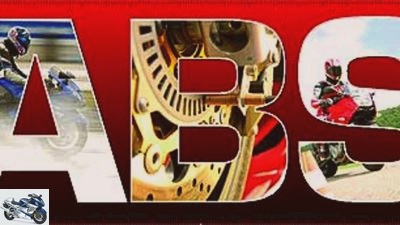
motorcycles
ABS special
ABS special
The state of affairs
Today only a few incorrigible people are still discussing the point of ABS in motorcycles. The implementation is the topic. MOTORRAD went in search of the status quo with eleven machines and different anti-lock braking systems.
Stefan Kaschel
09/04/2006
The technological backwardness of the two-wheeler industry compared to the four-wheeled guild is sometimes astonishing. Not only when it comes to exhaust and mixture preparation technologies. Even where motorcyclists are more dependent on the support of modern technology than any motorist, surprisingly little has happened so far.
Electronic vehicle dynamics controls are still not in vogue in the industry today. Just imagine: In the four-wheel group, perfectly functioning anti-lock braking systems are part of the standard equipment of almost every small car. To this end, the trade press and the insurance industry are unanimously calling for all cars to be fitted with electronic stability programs (ESP) as standard. With us, 25 years later, the anti-lock braking systems begin to pull across the board. This fact becomes even more grotesque in view of the ludicrous power-to-weight ratios (one kilogram per horsepower for super athletes) and acceleration times from zero to well below ten seconds
200 km / h and top speeds of up to almost 300 km / h. The whole thing extended on palm-sized tire contact surfaces and fully aware that a locking front wheel can almost be considered a fall guarantee.
But now the time has finally come. ABS is finding its way into almost all motorcycle classes from almost all brands. Even previous ABS refusers like Suzuki and Kawasaki are now there. With the three BMW models R 1200 R selected for this test, K 1200 S and F 800 S, with the Honda CBF 1000 and the travel enduro Varadero, with the Kawasaki ZZR 1400, the Suzuki V-Strom 650 and the Yamaha FJR 1300 as well as the Europeans Ducati ST3s, KTM 990 Adventure and Triumph Sprint ST, eleven motorcycles of very different classes and areas of use are available.
Buy complete article
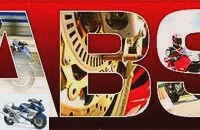
ABS special
The state of affairs
12 pages) as PDF
€ 2.00
Buy now
There was ample opportunity to demonstrate the capabilities of modern motorcycle anti-lock braking systems. In addition to the braking test on a level country road surface (which is why the values determined here may differ from the top test measurements on closed-off terrain), emergency braking on a rough road and on the ADAC test site in Hockenheim was on the program. There, the anti-lock devices were able to prove their capabilities not only in the wet, but also in the case of jumps in the coefficient of friction caused by a wet zebra crossing. Under conditions in which a normal Otto driver would not even have looked at his brake lever. But the times – so much in advance – now seem to be over for good on the motorcycle as well.
In the dry
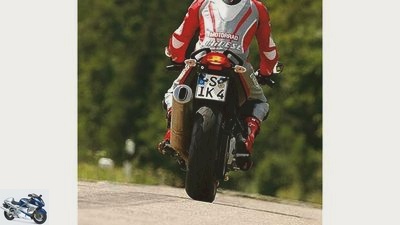
archive
In the iron – no reason for a fall with ABS.
If brilliant deceleration values are achieved in the MOTORRAD-Top-Test without ABS help, these are created under “laboratory conditions”. On a closed route and on an ideal surface. After several attempts. They are driven by experienced testers. The majority of motorcyclists will grit their teeth on this attempt. The line between maximum deceleration and a locking front wheel is too narrow.
So it was high time for the ABS triumphant advance in the motorcycle sector. Because one thing is certain: Anyone who decelerates heavily under the most difficult conditions and has convinced themselves of the efficiency of modern anti-lock braking systems will not want to do without this level of security in the future. Especially because braking from 100 km / h to a standstill is a noticeable, rock-hard physical battle for every additional half a meter.
That is true even on the normally very comfortable Yamaha FJR 1300, which is not exactly covered with glory in this chapter. It marks the last place by far. The average deceleration averaged over several tests is 7.86 m / s2. From an input speed of 100 km / h, the Tourer will stop after a good 49 meters at the earliest, which is significantly later than all the others. In spite of that, the way there is a tough ride for man and machine. The reason for this is the pronounced, long control intervals with which the FJR-ABS not only gives away valuable meters, but also allows the driver to clearly feel the supposed grip limit of the tires. Given the five meters to the penultimate, the Triumph Sprint ST, but especially given the phenomenal R 1200 R braking distance of 37.4 meters (10.32 m / s2), one can assume that the Yamaha operates well below the optimal slip limit.
The rest of the field is not that far from it. The consistently pleasing performance ranges from just under nine (Honda CBF 1000) to just under ten m / s2 (Ducati ST3s), with clear differences in control comfort becoming apparent. Honda in particular has this process well under control, both with the complex Varadero system and with the simple CBF-ABS (see technical box on page 27), while the Ducati regulates effectively, but extremely aggressively. Even on a flat track where the conditions remain constant.
That changes with the second braking attempt, carried out on the notorious MOTORRAD kickback test track. Short, hard edges, flat and high waves, randomly scattered bumps and holes, changing surfaces. And again the R 1200 R shows that both are possible with the latest edition of the BMW ABS. After an impressively quiet ride, during which the Telelever system prevents the front from submerging and thus provides enough suspension travel for the worst humps even when fully on the brakes, the Roadster comes to an incredible 42.9 meters. Some candidates cannot do much better, even on ideal terrain, while almost half of the test field loses more than ten meters. The Yamaha FJR, which only comes to a halt beyond the 54-meter mark, comes in last.
At least unlike some other motorcycles, the stretched FJR does not tend to somersault forwards. The Ducati ST3s, on the other hand, are occasionally frightened by sudden, unwanted stoppies, to which the driver has to react by quickly releasing the brake lever if he wants to avoid the rollover. Newer systems use complex controls to try to prevent the rear wheel from lifting off. However, since a sensor that can detect the angle of inclination of the motorcycle has not yet been used in any motorcycle, the lifting of the rear wheel must be “calculated” from other parameters. For example, with the latest generation of Bosch ABS, the slip of the front and rear wheels is balanced. If the system detects a sudden increase in slip on the rear wheel after a certain minimum delay, the computer opens the front brake to prevent the supposed rollover.
The previous BMW integral ABS also works in a similar way. In practice, this means that occasionally, for example when downshifting hard during braking, the front brake opens well before the slip limit is reached. As a result, of course, braking distance is also wasted, the loss of braking distance due to such control processes usually not being particularly great. However, temporarily opening the brakes can unsettle the pilot in practice. That is why many drivers would like better rollover sensors than, for example, the F 800 or the KTM 990, with which, with a brisk driving style, you often come into the control range, although the tire grip is still far from the limit range. Nevertheless, effective rollover detection is a mandatory requirement for the future use of anti-lock braking systems on sporty motorcycles. Because such machines with a short wheelbase and a high center of gravity would roll over smoothly without such a control function, for example when braking over bumps or when there are jumps in the coefficient of friction.
In the wet
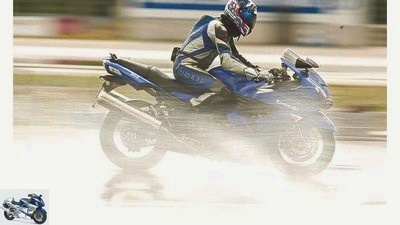
archive
In such weather, the ABS can show its advantages to the full.
The ADAC safety center behind the Mercedes grandstand in Hockenheim, where MOTORRAD was kindly allowed to do its wet braking tests, has everything that civil road traffic has to offer in the way of obstacles. The evenly distributed sprinklers ensure that the area can be watered continuously. In addition to the compulsory brake measurement, there was another exercise on the program that had a lot to offer: It was necessary to complete the entire braking on a checkerboard pattern on which around 20 centimeters wide strips with a coefficient of friction that correspond to that of a wet zebra crossing with non-slip asphalt strips alternate.
But first to the supposedly easier exercise. Braking in the wet. Anyone who thinks they are fit in this regard even without ABS has not yet pushed the K 1200 S with brake booster and the penultimate generation of ABS to its limits. Although not quite as finely and smoothly regulating as the R 1200 R, the combination of an extremely long K-wheelbase, Duolever front wheel guidance and, if necessary, powerfully gripping, braking force-loaded pliers cannot be cracked. After an unbelievable 40.9 meters, the K is more dry than most of the Japanese competition. This corresponds to a deceleration of 9.43 m / s2. Those who have not tried this before can probably not imagine such a delay, even in the case of drought. Just as little as a brake lever acrobat who exercises this exercise on a flooded route.
This also applies to the performance of the other candidates. Even the FJR, who is also at the bottom of the field in this discipline, puts a wildly regulating performance on the wet floor that a driver would never dare to brake. The result: a standstill after a considerable 50.3 meters, which corresponds to a deceleration of 7.67 m / s2. And amazingly almost what the FJR was able to do on dry surfaces. Just as if a braking power in this area was stored as a maximum in the FJR-ABS, so that the control valves boycott any further delay by reducing the pressure.
The rest of the field is largely found at values between 44 and 45 meters, the KTM 990 Adventure and the Ducati ST3s are well above it at more than 46 meters. The Ducati example in particular, which was able to shine when measured under ideal conditions, makes it clear that the ABS phenomenon cannot be dealt with using simple principles any more than with simple solutions. It takes a lot of experience – and maybe also a lot of errors, as the disappearance of the brake booster in the latest BMW ABS generation shows – to create an ABS like that of BMW R 1200 R to realize. It does well again in the spray, delivers the second-best result with 43 meters and almost nine m / s2 deceleration and controls so finely that you can hardly feel it, at least in the hand lever.
In addition, the new, partially integrated system of the R, in which the hand lever also activates the rear brake, together with the K-ABS, which also works according to this principle, shows how important it is to use the rear brake in the rain. Braking distances of almost the same length, regardless of whether the foot brake lever is activated, and the clear differences between conventional braking systems speak for themselves. If you only brake at the front in wet conditions, you are wasting valuable meters because the dynamic wheel load distribution with the shifting of the center of gravity forwards is far less important than under ideal braking conditions. There is a lot more load on the rear wheel, which can brake so energetically. The impressive example of this is the V-Strom 650, where the difference is around ten meters.
In the next exercise, even a perfect driving behavior pattern will only help to a limited extent. The wet checkerboard pattern, one jump in the coefficient of friction (µ = 0.8 on wet asphalt to µ = 0.2 on the painted stripes) after the other – the nightmare for everyone who wants to come to a safe standstill under these circumstances. Next. But even the first attempt with the K 1200 S shows that all fears are unfounded. Stable, safe and only at the end with noticeable control processes, it prances across the course and clearly shows with a braking distance of only 55.50 meters that the control technology has to do the hardest work here.
And it does that convincingly, because the deceleration of 6.95 m / s2 is the second best value achieved in this discipline. The only thing better is – no, not the R 1200 R, but the F 800 S. With 53 meters and a deceleration of 7.28 m / s2, it is the only one that manages the seventh mark. Under these difficult conditions, however, with clearly noticeable control intervals. Sister R lies more calmly there, controls more finely, but gives away meters. Just like the mighty ZZR 1400, which also comes up with fine control intervals, but never allows the high slip that is the optimum in wet conditions.
And the rest? Does more (KTM, CBF 1000) or less honestly (V-Strom, Sprint ST, Varadero, ST3s), whereby the Enduros with their long suspension travel draw attention to themselves through fork flutter. Oh yes, the FJR carries the red lantern. As always.
The technology

archive
Nothing works without modern technology. Here BMW’s integral braking system.
Eleven motorcycles, eleven different anti-lock braking systems – but it’s not that complicated. First of all, there are two fundamentally different functional principles according to which an ABS can function. On the one hand there is pressure modulation via solenoid valves, on the other hand via pistons (plunger system). It is not easy to say what is ultimately better. BMW relies on valve systems for the latest ABS generation (R 1200 R), while the predecessors were based on plunger systems. The Bosch Brembo systems used in the Ducati and KTM work with valve technology. The same applies to ABS from Kawasaki, Suzuki and Yamaha, which are technically related to the Bosch system. The second ABS pioneer Honda is going its own way. There, too, two systems were and are used, as at BMW, in the CBF the cheaper magnet system and in the complex, integral CBS-ABS units (Varadero, VFR, Pan European) modulators with servomotors, i.e. plungers.
Keyword CBS or integral brake system: The networking of the front and rear wheel brakes (partially integral on the R 1200 R, i.e. the foot pedal continues to only operate the rear wheel brake, fully integral on the Varadero) naturally also has consequences for the ABS. If the rear brake is also activated via the handbrake lever, the ABS must take account of the wheel load distribution that changes during braking and distribute the braking force accordingly. At Honda, this task is carried out by the brake force control valve, while BMW controls electronically.
Even when building up the brake pressure, Bayern went their own way at times. Similar to a car, a brake booster builds up additional pressure on the K 1200 S. However, this brings with it problems in terms of metering, but fundamental functional defects in the K 1200 system did not occur during this test (see MOTORRAD 10/2006). Neither the ABS nor the brake booster failed. Basically, the following can be said about the failure problem: Many systems have not (yet) programmed certain driving states. A spinning rear wheel on gravel is sometimes enough to throw the ABS out of step.
The history
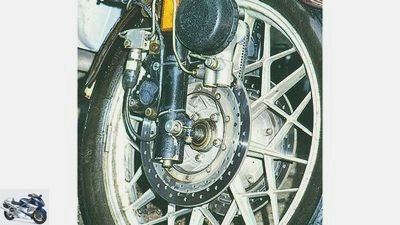
archive
The SCS system was still a bit clunky.
A good 20 years ago MOTORRAD was wrong. How wrong, but with the best will in the world, no one could foresee. “The recent history of motorcycle brakes has two distinctive cuts. In 1969, Honda made the disc brake socially acceptable with the revolutionary CB 750. In 1985 this system was perfected by Lucas Girling’s Stop Control System (SCS).” Quote end.
There are many reasons why it would be more than 20 years before this prognosis became a reality. A central aspect: from an aesthetic point of view, the crude hydraulics and mechanics could not convince. The function of the Girling system, in which an additional flywheel was connected to the wheel via a centrifugal clutch and a ball ramp mechanism, was already impressive in the test at that time. “In wet conditions, every beginner brakes like world champion Freddie Spencer”, enthused author Heiner Buchinger. He meant deceleration values around six m / s2. Today, a K 1200 S delivers 9.43 m / s2 on a wet runway, with the progress certainly not only manifesting itself in the ABS technology, but also in terms of the chassis and tires.
Speaking of BMW: It was a K 100 RT in 1985 that MOTORRAD carried out these braking tests. Since then, Bayern have stayed on the ball, reducing the weight of their anti-lock device from over eleven kilograms in the ABS 1 in the K series in 1988 to 2.3 kilograms in the R 1200 R and increasing the performance. An electronic control unit already specified the control intervals in ABS 1.
At that time, competitor Honda was still exclusively dedicated to hydraulics and mechanics and in 1988 presented a CBR 1000 with MC-ALB system, in which the hydromechanical anti-lock unit was positioned between the master brake cylinder and the brake caliper. Technically based on the Lukas Girling system, this solution was far more attractive than the first attempts in 1985. However, this system was also unable to establish itself. It never went into series production. The breakthrough came at Honda with an electro-hydraulic system, which was offered for the Tourer ST 1100 from 1991.
Yamaha followed suit in 1992. In the innovation carrier GTS 1000, an ABS was used in addition to the stub axle steering. The system convinced in a comparative test, delivered better values and more control comfort than the ABS of the BMW K 1100 RS – and nevertheless disappeared again in the sinking. Just like the optional ABS on the Suzuki Bandit, which was offered in 1997. By the way: with 8.93 m / s2 and a braking distance of 43.2 meters, the GTS 1000 already delivered significantly better values than the current one FJR 1300 A. Yamaha has a lot of work to do in this regard.
Conclusion
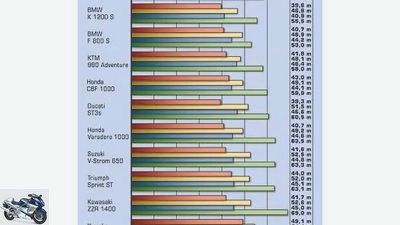
Image: Archive
The test results. Red: dry; Yellow: rough road; Blue: wet; Green: jump in the coefficient of friction.
Never again without! If you want to make it short, there can be no other summary after you have brutally decelerated eleven very different motorcycles under the most difficult conditions. Because what an experienced driver might be able to do by chance, the anti-lock braking systems practically conjure up on the asphalt as they pass. Well, it’s not quite by the way. It takes a lot of knowledge and
a lot of experience to tune an ABS so that it is not only comfortable and controllable for the driver, but also controls it as effectively as possible.
With the new R 1200 R, BMW shows how to get both under one roof, while Honda with its two systems only lands in the middle of the pure deceleration values, but is top class in terms of control comfort. But all other anti-lock devices – even the one from Yamaha – show that ABS is basically indispensable on a motorcycle. Or at least it will be in the future, when even outright sports motorcycles may soon be unsaleable in view of the increasingly lighter, more compact and more powerful systems without ABS.
Anyone who sees this as paternalism may think of Valentino Rossi. Without anti-slip regulation, the gifted gas generator will no longer go on the slopes. This is exactly what BMW is preparing for the R 1200 R. The hardware is already there.
Technical data Triumph Sprint ST
Three-cylinder in-line engine,
92 kW (125 PS)
255 kg
Double disc brake, Ø 320 mm, four-piston fixed callipers
Disc brake, Ø 252 mm,
Two-piston fixed caliper
Nissin
front / rear separated
Front brake
rear brake
11660 euros
800 euros
Technical data Yamaha FJR 1300 A
Four-cylinder in-line engine,
105.5 kW (144 PS)
292 kg
Double disc brake, Ø 320 mm, four-piston fixed callipers
Disc brake, Ø 282 mm,
Double piston floating caliper
Nissin
partially integral
Front brake
Brake rear / front
15,495 euros
included
Technical data Suzuki V-Strom 650
Two-cylinder V-engine,
49 kW (67 hp)
214 kg
Double disc brake, Ø 310 mm, double-piston floating calipers
Disc brake, Ø 260 mm,
Single piston floating caliper
Nissin
front / rear separated
Front brake
rear brake
7190 euros
included
Technical data Kawasaki ZZR 1400
Four-cylinder in-line engine,
140 kW (190 hp)
260 kg
Double disc brake, Ø 310 mm, four-piston fixed callipers
Disc brake, Ø 250 mm,
Two-piston fixed caliper
Nissin
front / rear separated
Front brake
rear brake
13,995 euros
included
Technical data KTM 990 Adventure
Two-cylinder V-engine,
72 kW (98 hp)
237 kg
Double disc brake, Ø 310 mm, four-piston fixed callipers
Disc brake, Ø 250 mm,
Two-piston fixed caliper
Brembo / Bosch
front / rear separated
Front brake
rear brake
12598 euros
included
Technical data Honda Varadero 1000
Two-cylinder V-engine,
69 kW (94 PS)
283 kg
Double disc brake, Ø 296 mm, three-piston floating calipers
Disc brake, Ø 256 mm,
Three-piston floating caliper
Nissin
fully integral
Brake front / rear
Brake rear / front
10290 euros
900 euros
Technical data Ducati ST3s
Two-cylinder V-engine,
78.8 kW (107 hp)
235 kg
Double disc brake, Ø 320 mm, four-piston fixed callipers
Disc brake, Ø 245 mm,
Two-piston fixed caliper
Brembo / Bosch
front / rear separated
Front brake
rear brake
12695 euros
included
Technical data Honda CBF 1000
Four-cylinder in-line engine,
72 kW (98 hp)
252 kg
Double disc brake, Ø 296mm, three-piston floating calipers
Disc brake, Ø 265 mm,
Three-piston floating caliper
Nissin
partially integral
Front brake
Brake rear / front
7990 euros
700 euro
Technical data BMW R 1200 R
Two-cylinder boxer engine,
80 kW (109 PS)
232 kg
Double disc brake, Ø 320 mm, four-piston fixed callipers
Disc brake, Ø 265 mm,
Double piston floating caliper
Continental / Teves
partially integral
Brake front / rear
rear brake
11200 euros
1050 euros
Technical data BMW F 800 S
Two-cylinder in-line engine,
62.5 kW (85 PS)
209 kg
Double disc brake, Ø 320 mm, four-piston fixed callipers
Disc brake, Ø 265 mm,
Two-piston fixed caliper
Bosch
front / rear separated
Front brake
rear brake
8450 euros
690 euros
Technical data BMW K 1200 S
Four-cylinder in-line engine,
123 kW (167 hp)
256 kg
Double disc brake, Ø 320 mm, four-piston fixed callipers
Disc brake, Ø 265 mm,
Double piston floating caliper
FTE
partially integral, brake booster
Brake front / rear
rear brake
14,500 euros
included
Related articles
-
Annette Johann to travel Alpine special Alpine special Three weeks at the top Either over 1800 meters high or under three meters wide ?? nothing in…
-
Chassis Special: Part 5 – Troubleshooting and Basics
Jahn accesories landing gear & Spring elements Suspension special: Part 5 – Troubleshooting and basics Suspension special: troubleshooting and basics…
-
Chassis special part 1: motorcycle suspension
fact accesories landing gear & Spring elements Chassis special part 1: motorcycle suspension Chassis special: suspension Everything about motorcycle…
-
Buy used – rare motorcycles and special models
Breakable 24 pictures Breakable 1/24 Alejandro Garcia, Neuss, Yamaha R6 Rossi Edition, EZ 6/2005, 14,100 km, 5,290 euros: the classy 600 is very well…
-
Two-cylinder special: base against noble
motorcycles Two-cylinder special: base against noble Two-cylinder special: base against noble For a handful of dollars more Content of Sure, you can buy…
-
Motorcycling under special conditions
Rosen Gargolov 12th pictures MOTORCYCLE 1/12 The measured values of a Honda CBR 600 F show how different road surfaces in the rain affect the braking…
-
PS-Tune Up special tips for screwing
23 pictures archive 1/23 Above: ideal case – 90 degree position. Bad posture like in the two pictures below can be prevented by adjustable footrests….
-
accesories Service special brakes Service special brakes Technology brake discs Ceramic brake discs are the latest hit. MOTORRAD had the opportunity to…
-
3 cylinder special – three cylinders from the 70s and 80s
fact 17th pictures archive 1/17 Kawasaki 750 H2. archive 2/17 Most drivers who wanted to take on the 750-H2 looked into the tube, or rather into these…
-
MV Agusta F4 Claudio special model
MV Agusta 34 pictures MV Agusta 1/34 MV Agusta has launched a new special model. MV Agusta 2/34 The special model is called Claudio and pays homage to…